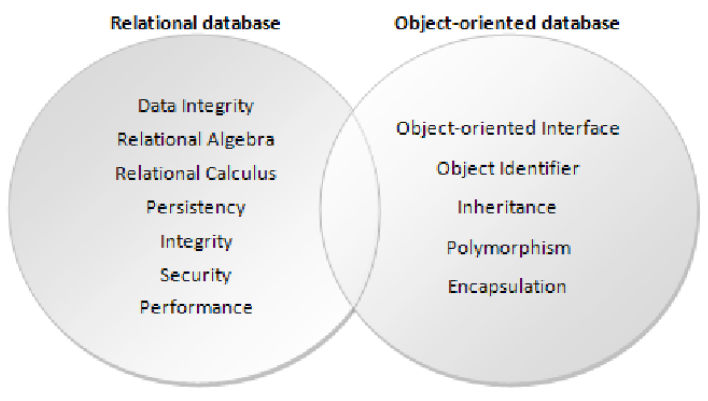What Is Object Relational Database?
An object-relational database (ORD) is a database management system (DBMS) that’s composed of both a relational database (RDBMS) and an object-oriented database (OODBMS). An object-relational database acts as an interface between relational and object-oriented databases because it contains aspects and characteristics from both models.
Object-oriented database (ORD) serves two main purposes:
- It connects the divide between relational databases and the object-oriented modeling techniques that are usually used in programming languages like C#, Java and C++.
- It bridges the gap between conceptual data modeling techniques for relational and object-oriented databases like entry-relationship diagram (ERD) and object-relational mapping (ORM).
What Is Object Oriented Database?
An object-oriented database is organized around objects rather than actions and data rather than logic. Therefore, an object database is a database management system in which information is represented in the form of objects as used in object-oriented programming.
Usually, when OODBMS is integrated with an object programming language, there is a much greater consistency between the database and the programming language because both use the same model of data representation. When compared to a relational database management system, an object-oriented database stores complex data and relationships between data directly, without mapping to relational rows and columns whereas a relational database stores information in tables with rows and columns.
Key Differences
Features Of Object Oriented Database (OODBMS)
- In object oriented database, relationships are represented by references via the object identifier (OID).
- Object oriented systems employ indexing techniques to locate disk pages that store the object. Therefore, they are able to provide persistent storage for complex-structured objects.
- Handles larger and complex data than RDBMS.
- The constraints supported by object oriented systems vary from system to system.
- In object oriented systems, the data management language is typically incorporated into a programming language such as #C++.
- Stores data entries are described as object.
- Object oriented database can handle different types of data.
- In the object oriented database, the data is stored in the form of objects.
Features Of Object Relational Database (ORDBMS)
- In object t relational database, connections between two relations are represented by foreign key attributes in one relation that reference the primary key of another relation.
- Relational database systems do not specify any data storage structure, each base relation is implemented as separate file and therefore, they are unable to provide persistent storage for complex-structured objects.
- Handles comparatively simpler data.
- Object oriented database has keys, entity integrity and referential integrity.
- In relational database systems there are data manipulation languages such as SQL, QUEL and QBE which are based on relational calculus.
- Stores data in entries is described as tables.
- Relational database can handle a single type of data.
- In relational database, data is stored in the form of tables, which contains rows and column.
Also Read: Difference Between DBMS And RDBMS
Object Oriented Database Vs Object Relational Database In Tabular Form
| BASIS OF COMPARISON | OBJECT ORIENTED DATABASE (OODBMS) | OBJECTED RELATIONAL DATABASE (ORDBMS) |
| Connection Between Two Relations | Relationships are represented by references via the object identifier (OID). | Connections between two relations are represented by foreign key attributes in one relation that reference the primary key of another relation. |
| Data Storage Structure | It employs indexing techniques to locate disk pages that store the object. Therefore, they are able to provide persistent storage for complex-structured objects. | It does not specify any data storage structure, each base relation is implemented as separate file and therefore, they are unable to provide persistent storage for complex-structured objects |
| Quantity Of Data | Handles larger and complex data than RDBMS. | Handles comparatively simpler data. |
| Constraints | The constraints supported by this system vary from system to system. | It has keys, entity integrity and referential integrity. |
| Data Manipulation Language | The data management language is typically incorporated into a programming language such as #C++. | There are data manipulation languages such as SQL, QUEL and QBE which are based on relational calculus. |
| Description Of Stored Data | Stores data entries are described as object. | Stores data in entries is described as tables. |
| Type Of Data | Object oriented database can handle different types of data. | Relational database can handle a single type of data. |
| Data Storage | The data is stored in the form of objects. | Data is stored in the form of tables, which contains rows and column. |
Venn Diagram Summarizing The Difference Between ORDBMS And OODBMS

Comments are closed.